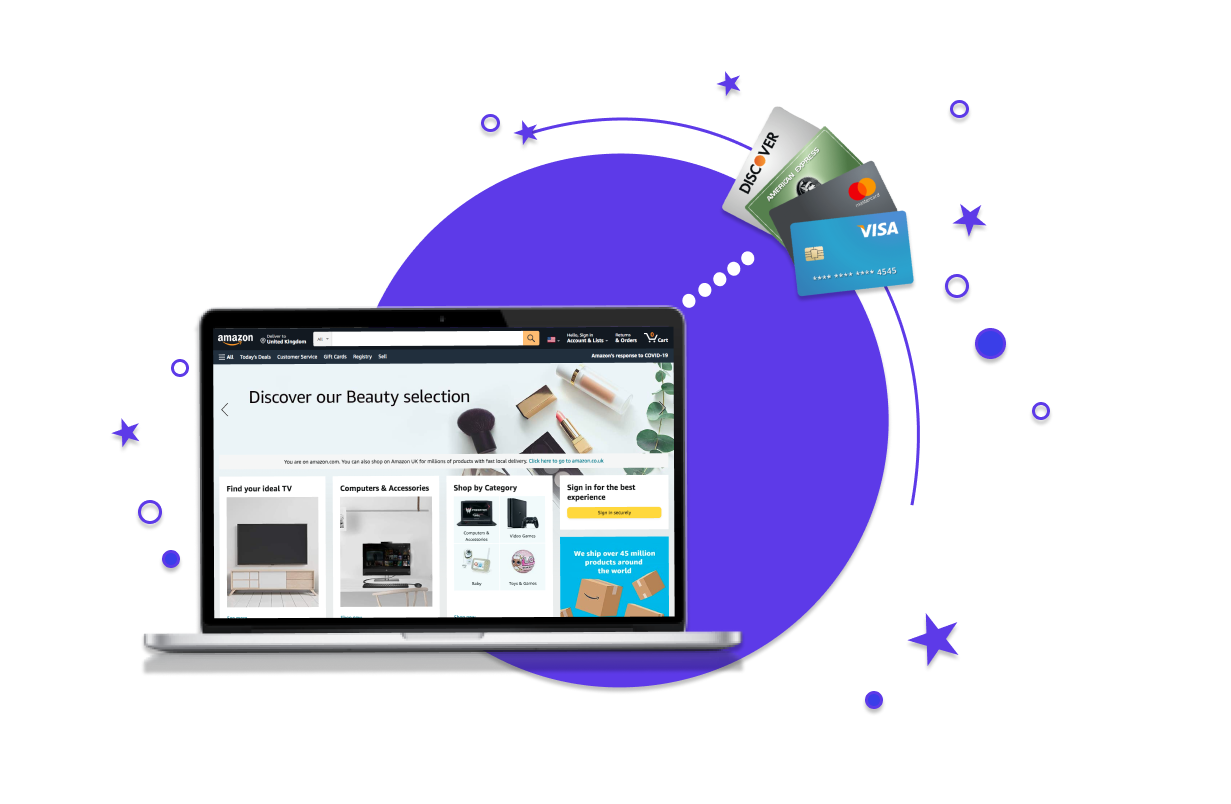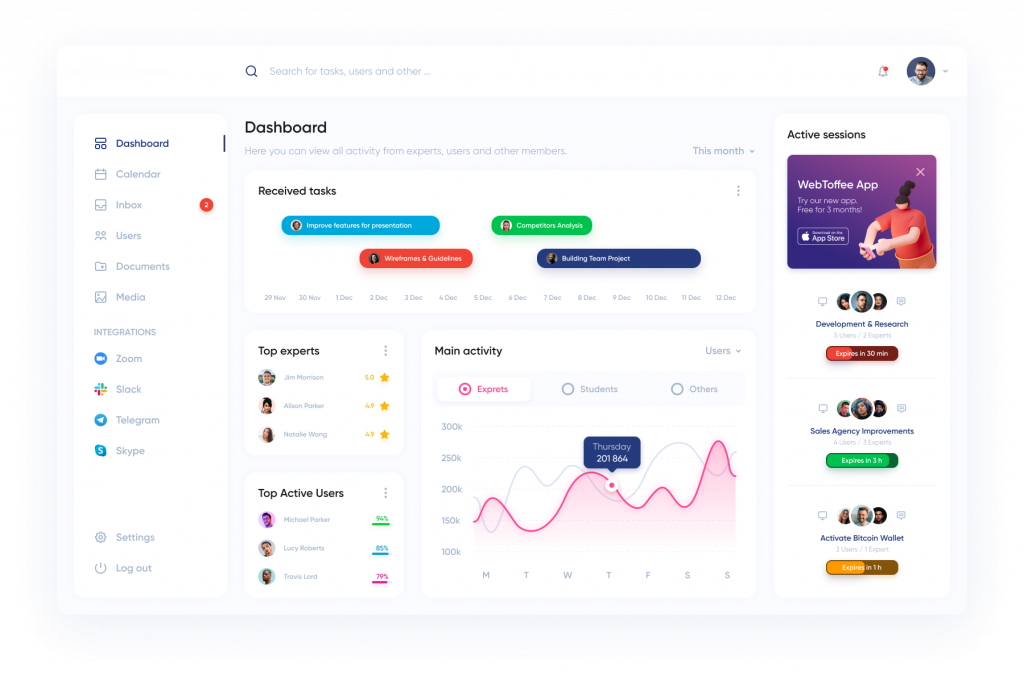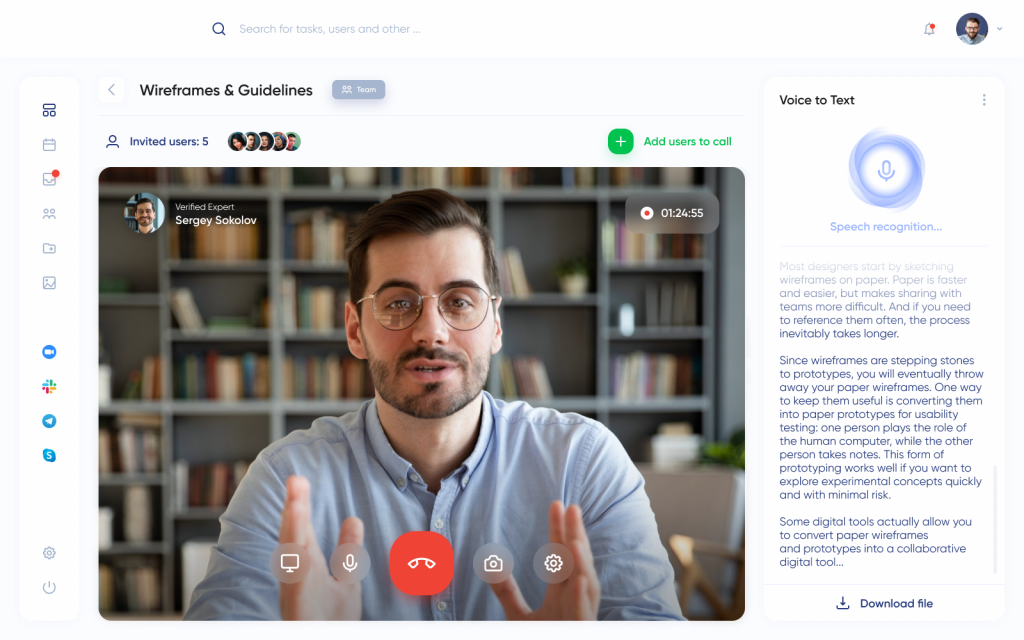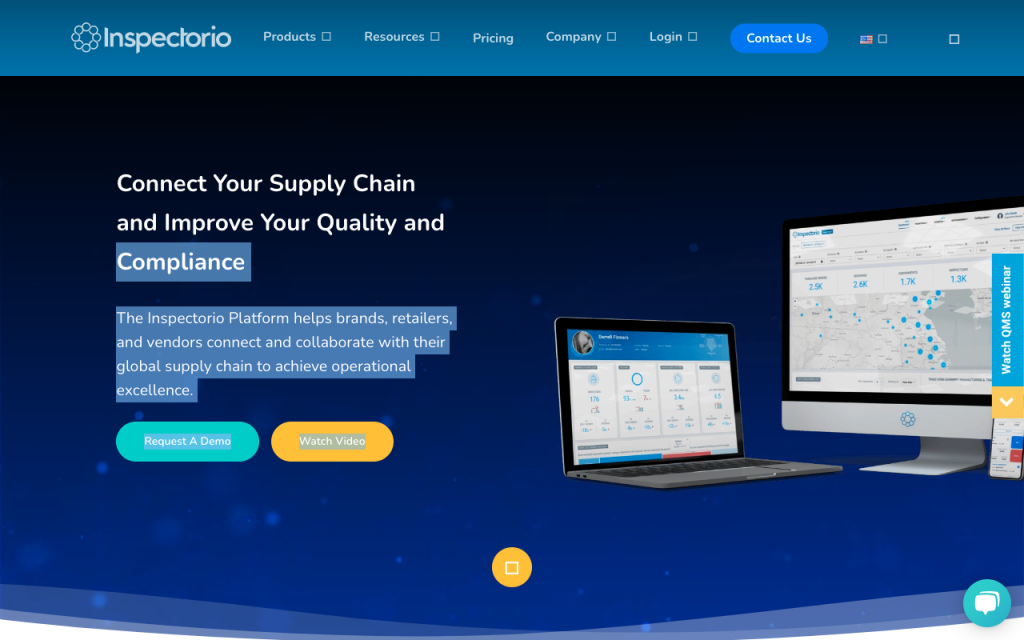Building an Online Marketplace MVP 101
Content:
- Minimum viable platform for the marketplace: where to start?
- What should you do before diving into the online marketplace building
- Building an MVP and getting customer’s feedback
- Marketplace case studies from Jellyfish.tech
- What’s next?
Minimum viable platform for the marketplace: where to start?
Before jumping to the marketplace MVP creation, we should go through a boring part defining the main concepts I’m using in this post.
If you’re a super tech-savvy person, good for you! Scroll down to the “What should you do before diving into the online marketplace building” section.
What is an MVP?
A minimum viable platform is the first version of your product with only basic functionality included that could solve the problems of your target audience better than any other application existing on the market.
MVP is one of the ways to test the validity of your business idea by providing a tangible value to your future customers and measuring their feedback.
What is a marketplace?
A marketplace is a digital platform that makes supply & demand meet and processes the payments.
Although the multi-vendor online marketplace can look differently and come with different offerings, it’s always a platform to get a service/product provider and seeker together.
During the last two years, the number of people who prefer buying and selling online rose significantly — over 75% of consumers buy something online at least once a month according to Bigcommerce.com.
The total e-commerce revenue is predicted to reach more than $500 million dollars in the U.S. by 2022:
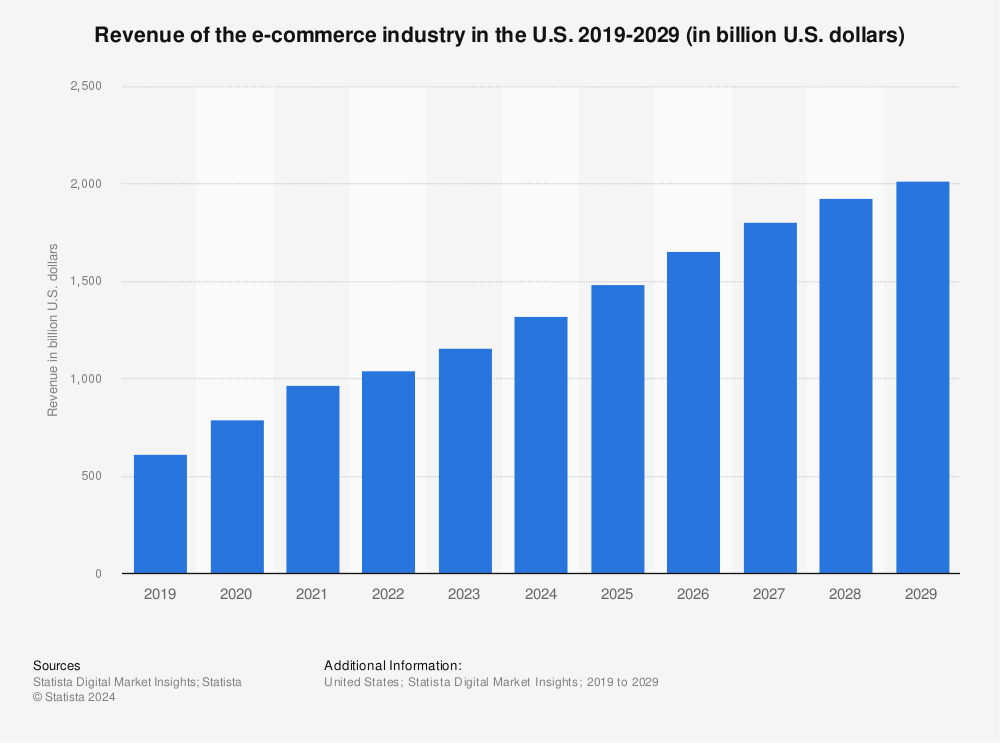
Find more statistics at Statista
According to the statistics, the demand for online shopping including all kinds of marketplaces will be growing year by year.
What does it mean for the person who’s thinking of building a marketplace?
It’s the right time to turn your idea into a workable product, validate and start earning money connecting sellers and customers on your platform.
Types of marketplaces
Getting through dozens of marketplace classifications can be confusing (I was indeed confused when trying to put the info together for this post), so the best option is to start with the basics. So I’m about to determine the marketplaces by target audience and focus.
Marketplaces by target audience
From micro-vendors to enterprises, every business could find a platform fitting their requirements, size, and target audience.
B2B. A business-to-business platform where a company could either hire a vendor or buy the product produced by another company — Clutch.
B2C. A business-to-customer marketplace where an individual could order literally anything delivered by small and medium businesses (sometimes enterprises as well) — Aliexpress.
C2C / P2P. A customer-to-customer (or peer-to-peer, as we presume all participants are equal) platform for individuals to sell both used and new items — Uber.
Marketplaces by focus
Horizontal marketplaces focus on buying & selling all kinds of goods.
Vertical marketplaces operate for providing a product or service in a specific niche.
“Hot” marketplace verticals you should consider in 2021:
Freelance marketplace. We’ve been switching to freelancing for many years, letting the pandemic contribute to the ever-growing demand for remote freelance specialists. Many small, medium, and even large businesses indeed prefer cooperation with freelancers instead of hiring in-house employees.
What could we get from this? Freelance marketplaces (the classic example of which is Upwork) are booming so why don’t consider this as an opportunity to bring a new perspective?
Examples for inspiration: Upwork, Fiverr, Guru.
Recruitment marketplace. The popularity of recruiting hubs that connect candidates and recruiters seeking to hire/be hired in-house is also on the rise. The most advanced of these marketplaces often use artificial intelligence & machine learning algorithms to ensure the best fit and simplify the recruitment process.
Examples for inspiration: BountyJobs, RecruitingHub, HiringHub.
Education marketplace. You probably know that the education industry was driven online reacting to the world’s quarantine and self-isolation tendencies. No matter if it is an online course marketplace or a platform to connect tutors and learners, they all have great potential.
Don’t be scared by the variety of the existing online learning-related applications: there is always room for a good idea!
Examples for inspiration: Udemy, Vitutors, Preply.
NFT marketplace. We experienced a real NFT madness in March 2021: online platforms for buying & selling the NFT (non-fungible tokens) pieces were on the rise!
Let me explain the concept of NFT for those who are living their best life instead of wasting time on another digital crap (if you’re in the loop — please, don’t be mad at me and scroll down to the travel marketplaces:).
Non-fungible token (it’s called a crypto collectible, as well) serves as a one-of-the-kind representation of a digital asset or good. Basically, it’s a unique line of code stored in the digital object for defining the owner, allowing the object to still be circulated around. Everything stored in digital format can become an NFT.
Think of this as a way to protect your digital property on the web, and officially buy/sell this property using cryptocurrency.
Although the hype around the NFTs started to decrease, it’s still a big step towards keeping the copyright and monetizing the digital works.
Examples for inspiration: OpenSea, NiftyGateway, Foundation.
Travel marketplace. The travel industry is slightly recovering and gaining momentum, so do the products aimed at enhancing our traveling experience. Can’t help mentioning my fav Airbnb here, which is an excellent example of a well-functioning marketplace with great support — take my word for it (this post isn’t sponsored by Airbnb!).
Examples for inspiration: Booking, CouchSurfing, Peek.
Real estate marketplace. Getting realtors, property owners, and customers together on a digital platform is a real way to boost a real-estate business. Checking the list of properties available in a specific location and comparing them online, booking a virtual tour, or contacting the property manager for detail via a live chat, for example, will help agencies expand the reach and increase visibility. Not to mention getting your commission as a marketplace owner.
Examples for inspiration: Zillow, Consorto, BiggerPockets.
There’s also a bunch of marketplace verticals including the local platforms for selling & buying new and used cars, clothes, all kinds of handmade, cleaning, moving, repair services, etc. — the list could be endless.
The truth is you can start a marketplace literally for every product or service coming to mind. However, at this stage, our main task is to learn how you could check the validity of your idea by building an early version of your product that won’t cost an arm and a leg.
Marketplace monetization models
The technical side of the marketplace creation together with the best practices are definitely important, but without a good monetization strategy and a marketing campaign, the technology is powerless.
Of course, the essential task for the marketplace owner is to make a profit. That’s why the choice of a business model is one of the key factors determining the future success of your marketplace:
- Transaction fees. This is the most common way to monetize the marketplace. The commission can be paid by the seller, buyer, or both.
- Monthly fee. In this case, a regular fee is applied for using the service.
- Payment per advertisement. The seller pays for showing their ads to a large marketplace audience.
- Pay per contact. The marketplace charges a fee for delivering a lead who is interested in a particular service. Of course, there is no guarantee that the deal will be closed. However, the PPC conversion is usually higher in comparison with placing ads.
- Freemium + additional features. The marketplace allows the consumer to use the basic functions for free but charges for the use of the additional features. Peerby is a good example of a marketplace for borrowing things that offers additional paid services insurance in case the borrowed item is not returned or is broken.
- Featuring. An opportunity to buy a specific position on the listing of a specific service or a product that corresponds to your niche.
Often marketplaces combine several types of monetization (Etsy, for example, a site that focuses on handmade products). It applies a transaction fee and also allows placing ads.
In fact, the marketplace monetization will also depend on your industry & users, together with the best practices you could get inspired by.
E-commerce solution vs custom solution for marketplace MVP
Googling the people’s opinions on building the minimum viable marketplace platform, I’ve bumped into a curious Reddit thread bringing up the issue every startup founder encounters: is it worth going for custom development or is it better to choose one of the half-ready e-commerce solutions.
I understand the concern of people voting for using the ready templates and tools for creating the product, it’s a way cheaper and could be a good option in case you have to show a thing to investors.
However, it’s never as simple as it sounds. No matter which way to go you choose, the pitfalls are still there.
| E-commerce solution | Custom solution | |
| Time | Whenever it takes you to build the functionality you need. | You can get MVP done in 4-6 weeks. |
| Money | “DIY” will cost you significantly less than custom development. | Custom product development is expensive. That is a fact. |
| Efforts | Your maximum efforts are required as well as the full understanding of the process you can’t get without going into details yourself or asking friends’ advice. | An agency will guide you through the processes smoothly, keeping you in the loop but not overwhelming with the information. |
| Product interface | Ready-made templates of e-commerce builders usually don’t provide much flexibility. It may be impossible to get exactly the look you want or it’ll require deeper customization through code. | Your product will look good even without designs — we could apply the best practices of UI/UX using the Angular Material library. |
| Functionality | Your product features will be limited by the builder’s functionality. Even if you choose the builder that is able to handle your killing feature, you’ll probably face difficulties with future product enhancement and scalability. | You’ll get exactly the features you want, working perfectly. The modular architecture allows for great scalability and future improvements. |
| Your involvement in the process | 100% required. | 30% required. |
Of course, the price for custom web development will depend on the company you’re about to hire. And there are definitely some ways to cut costs: it may be outsourcing to India (with all the consequences) or getting the technical advantage as we do at Jellyfish.tech.
As we’re mainly working with startups, developing a minimum viable product for them, it’s crucial for us to optimize this process and provide a better service. So instead of building a product from scratch each time, we’ve set up an “assembly line” — a starter development kit (SDK) that actually covers the common product functionality from authorization to media upload.
Yes, this one-time action required knowledge & extra hours of the development team; however, we optimized the “production”, enabling our customers to get the first product version in 4-8 weeks depending on the complexity and save money.
The choice isn’t easy and actually reminds me of this:
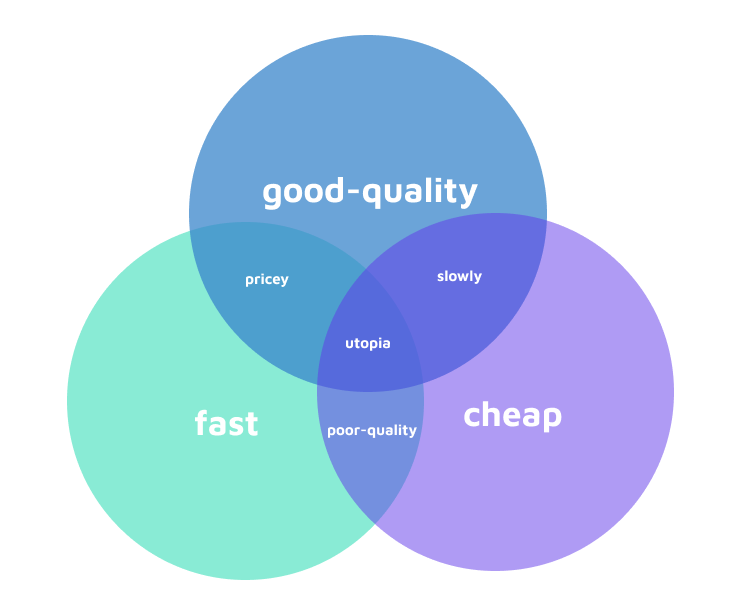
As you can see, there is no magic pill for having everything at once. Of course, it’s up to you to decide which option to choose. What I could definitely recommend is to set the priorities and properly estimate your resources.
Building a product (or even part of its functionality) from scratch by yourself isn’t a piece of cake — especially having no technical background knowledge or coding skills. In this case, a steep learning curve and a need for getting through a lot of information yourself would be the essential part of the process.
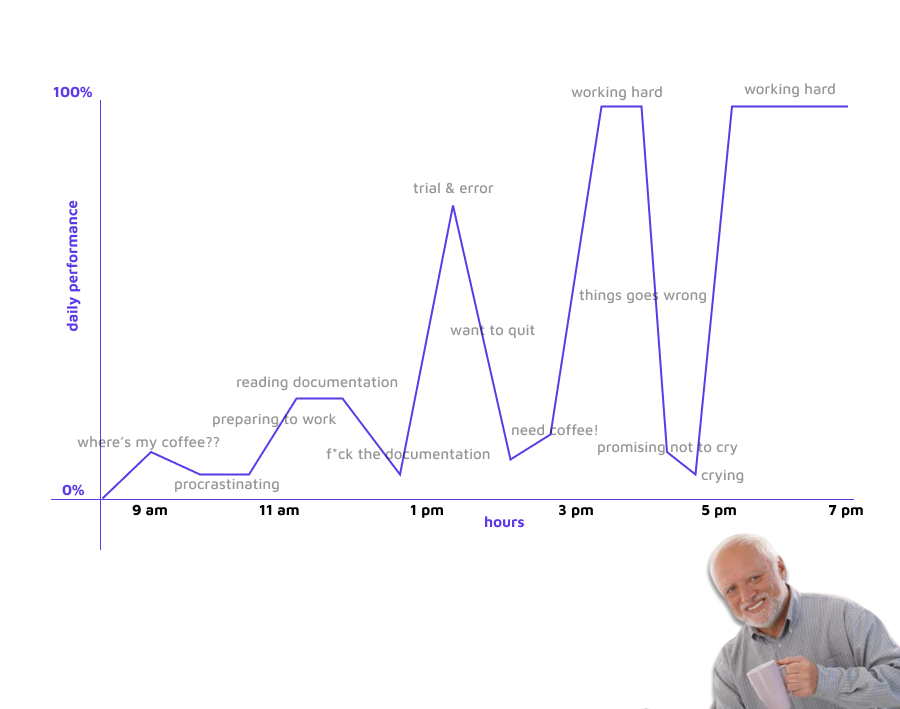
Of course, having the budget, it’s better to go with the custom solution for the reasons I’ve mentioned above — the look and functionality of your product will be just as you want it to be.
Plus you shouldn’t spend all your time managing the technical side of the project. This lets you dive into the other but not least important startup founder activities: defining and connecting with your future customers, searching for product-market fit, marketing, etc. that smoothly brings us to the next section.
What should you do before diving into the online marketplace building
Don’t invest in a product until you find customers who will be ready to pay at least $5 for using it
Kseniia Goldovska, CEO at Jellyfish.tech
Of course, you want to verify your idea the quicker the better and proceed to the MVP development phase. In our book, by accepting this approach, you risk skipping some important steps for forming your product hypothesis as accurately as possible. Actually, these steps help you lay the solid foundations for making sure your product will appeal to your target audience and people will pay for using it.
On the way to building your marketplace MVP, ask yourself the following questions (some of them can be optional depending on your requirements, but you should definitely think them through):
1. Who are my customers and do they need my product?
In other words, you should determine product-market fit: a level of match between the requirements of your future users and the value your platform could provide. This is definitely a complex and hard-to-measure concept and a huge goal no one but a startup owner can strive to achieve. I’m not sure anyone has 100% achieved it yet, and, honestly, don’t think it’s possible. Let’s consider product-market fit as an ideal scenario we can’t reach but can strive for. A long and complex process of finding PMF is based on iterations and aimed at learning who your customers are and improving your product. It involves multiple factors and requires industry knowledge, market research, and customers interviews that can be partially covered during the next step.
2. What features should my product have?
Product discovery will help find this out. This process is aimed at reducing the chance of making a mistake when defining the audiences, their problems, and the ways to solve them with the help of your product.
So it’s actually important to describe, document, and prioritize your users’ requirements in the form of user story maps or use cases to understand which features are “wanted” by your customers.
The product discovery specialist helps
- deeper understand problem-solution fit through market research and customer development interviews;
- define your value propositions (the trick is you usually have to come up with two value propositions: one for a service or product provider and another for a customer);
- collect and write down the high-level requirements turning them into the specific tasks (user stories) to be completed by the developers’ team;
- create the feature list;
- design a roadmap — a comprehensive plan of product development.
3. How do my customers behave?
Conducting UX research helps understand which way your users go to achieve their goal for delivering the superb experience of interaction with your product.
Although you should get a basic understanding of your customers’ behavior (btw, you can use the references they provide during the interviews, form a focus group, or hire the user research specialist who would do this for you), we don’t recommend spending too much time diving into the research.
You could get back to this after launching the product, having more options to collect accurate data about your customer’s behavior.
4. What should my product look like?
Design could help your product stand out from the crowd and engage your target audience through compelling visuals. However, our team usually does not recommend getting stuck on the design stage when developing the first product version. We believe our main goal is to build the features that will cover your customers’ needs, and only after you make sure your users want this product, you should start to think of how it looks.
Excluding the design, we could still build the product interface using the Angular Material UI library that reduces the time to market and the number of resources spent on building the early version of your product.
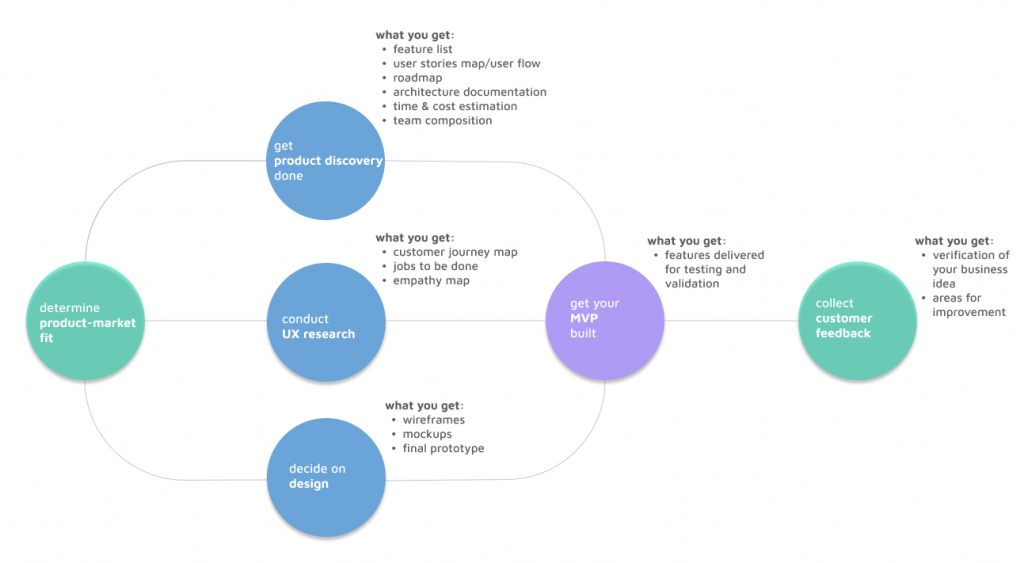
When completing these steps successfully (their number actually depends on the available resources and specific features of your target audience), we can proceed to a prototype creation — a kind of a draft that will be further turned into an actual product by the development team.
Building an MVP for a marketplace and getting customer’s feedback
“How much does it cost to build an MVP for a marketplace?” — it’s probably the main question you have.
I’ve asked our technical team lead to make a rough estimation for you with and without using our starter development kit to get the very approximate cost of building the MVP of your future marketplace.
Disclaimer. Please, keep in mind that we considered the simplest “version” of a feature. In case it’s larger and more complex, the number of hours will increase as well.
| Feature | Hours, without SDK | Hours, with SDK |
| Authorization | 30 | 12 |
| User profiles | 20 | 16 |
| Payment integration | 30 | 8 |
| Media upload | 6 | 3 |
| Chatbot for users’ onboarding | 30 | 20 |
| Messaging | 60 | 30 |
| User roles | 10 | 4 |
| Homepage | 20 | 14 |
| Admin panel | 30 | 16 |
| Search | 8 | 6 |
| Filters | 18 | 10 |
| Recommendation system | 30 | 14 |
| Shopping cart | 20 | 10 |
| Notifications | 14 | 6 |
| Product gallery | 20 | 10 |
| Reviews | 16 | 10 |
| Multi-language | 30 | 16 |
It would be great if we could finish here, but product development is a complex process, which doesn’t start or end with creating the features only. There’s always more to add to the estimate:
Code testing (unit, integration, etc), refactoring 160 / 40 h
Quality assurance 40 / 20 h
Project management 40 / 20 h
Infrastructure planning 30%
Yep, a lot of information. I wish I could explain every concept to you in detail, but in this case, the article will never end.
We’ll keep you in the loop during the free consultation you can get or just feel invited to subscribe to our blog, as more is coming!
| Total with SDK from Jellyfish.tech | 352 |
| Total without SDK | 822 |
After releasing the first version of your product, it’s all about collecting data and getting users’ feedback.
Get your MVP tested by the real users, observe their interaction with your product if possible, ask as many right questions as you can to figure out whether it works for your target audience.
Listen to your customers to see what they love the most and what can be improved.
Perform A/B testing to make sure you provide exactly what your users want and optimize your product’s UI/UX.
Of course, it would be only the beginning of the long cycle of iterations for improving your product, but you should still define the essential product growth metrics and track them consistently.
Marketplace case studies from Jellyfish.tech
Ask us “What do you know about marketplaces?”, and we’ll answer “Everything you need to build a superb product that brings profit”.
To demonstrate our experience, I decided to share the curiousest cases with you.
Education marketplace (NDA). A marketplace, where an expert could tutor & get paid for the consultation; and a learner could have a video call or a chat with an expert in a few clicks.
The Jellyfish.tech build the platform from scratch, including the mobile app and further improvements & support.
Top features:
- Online chat based on Web Sockets with integrated payment system;
- Video conferencing;
- Voice-to-text converter;
- Chatbot;
- Statistics dashboard;
- Task tracker;
- Mobile app;
- Gamification.
Inspectorio. We did this project for the supplier compliance verification company. The platform allows users to book an inspection of their products or factories and monitor the steps of the inspection online.
We built five pages for the inspection booking based on the mockups provided using Angular. Our team also implemented several Python APIs on the backend.
IT freelance marketplace. The platform actually is a kind of social network for experts in different industries and companies. It provides the possibility for experts to find the job matching their skills the most, and for companies to find a perfectly fitting expert for the team.
Our team was mostly responsible for developing user profiles, making possible:
- Uploading skills from the CV files, including file uploads;
- Uploading skills from the third party services (e.g. salesforce);
- Adding projects;
- Editing user profiles.
We also built a dashboard showing the statistics via charts and diagrams from scratch. It was made with the usage of d3.js, data visualization libraries, and Angular.
Event booking marketplace (NDA). A platform for managing/organizing offline/online events (concerts etc). Users are able to create an event, add unique tickets, get real-time analytics, and sell the tickets in one place. The system has a modern CRM, so the user is capable of tracking everything easier!
Our team built the platform from scratch.
What’s next?
Work on a product never ends: you’ll always need to get it improved, supported, or updated.
However, validating your business idea through MVP building is a huge milestone in your startup journey, based on which you could make a decision to keep on working, iterate, or step aside.
It’s always easier to go through this stage having a team of professionals on board, who not only could reduce the number of hours spent on the development but also know a thing or two about product management and startup challenges.
Have an idea? Book a call with our marketplace experts📲
P.S. Hope, there are no questions left about the basics of building the marketplace MVP after reading this post. Besides, if you have any questions, you could always join the Jellyfish.tech startup newsletter, schedule a free consultation with one of our experts, or add your question to the comments.
Thanks for reading!

